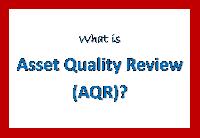
One of the leading financial sector problem is the rising NPAs with the banking system. In this context, accurately estimating asset quality is an important responsibility of the RBI. The central bank has several ways to examine the status of asset quality of banks. The most used one is the Annual Financial Inspection (AFI) through which the RBI makes inspects the balance sheets of every banks annually.
But the rising level of NPAs has tempted the RBI to come out with additional inspections on the balance sheets of the banks to check the genuine nature of bank assets. The RBI during 2015 has conducted inspection of selected banks’ balance sheets in random. The report from such inspection is termed as Asset Quality Review (AQR). So, AQR is the result of asset quality inspection by the RBI on commercial banks. Main feature of AQR is that it may not be periodic and rather it is random check.
Why the AQR became necessary?
RBI had a strong notion that some of the banks are underreporting their NPAs. Asset classification practices are not up to the mark and several banks have resorted to evergreening of accounts. Here, banks were postponing bad-loan classification while depicting accounts as performing.
AQR exercises
RBI made special inspections during August-November 2015 and prepared the AQR. Sample size of loans were bigger during the exercise. After the AQR, banks were given two quarters to complete the asset classification. RBI later revealed that AQR will not be made an annual or a frequent exercise.
Results of the AQR
The AQR by the RBI revealed higher level of asset quality deterioration or NPAs with the inspected banks. As per the review, almost all public-sector banks were having higher NPAs. In the case of private sector banks, the impact was limited to big lenders like ICICI Bank and Axis Bank.
Banks were reported to be hiding bad assets under the practice of forbearance. Actually, forbearance is a temporary postponement of mortgage payments. It is in the form of repayment relief granted by the bank to the borrower. Asset Quality Review has sidelined such practices to estimate the accurate level of NPAs.
*********









